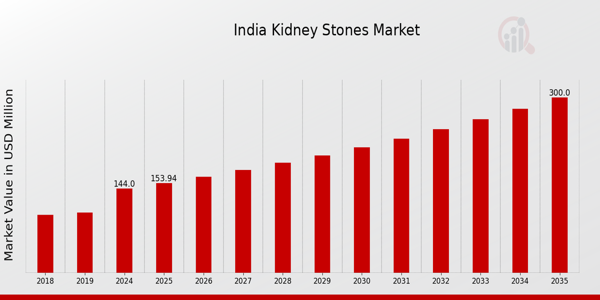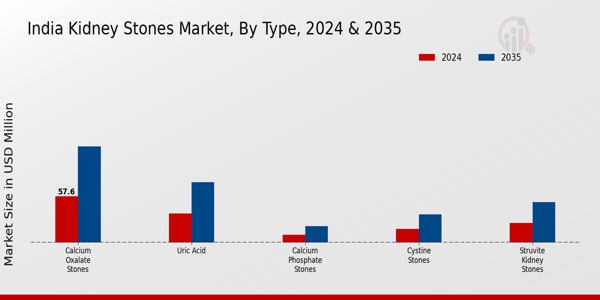India Kidney Stones Market Overview
As per MRFR analysis, the India Kidney Stones Market Size was estimated at 104 (USD Million) in 2023. The India Kidney Stones Market Industry is expected to grow from 144 (USD Million) in 2024 to 300 (USD Million) by 2035.
The India Kidney Stones Market CAGR (growth rate) is expected to be around 6.9% during the forecast period (2025 - 2035).
Key India Kidney Stones Market Trends Highlighted
The India Kidney Stones Market is undergoing some important shifts due to increased health awareness and technology, including the rising kidney stone incidences in India. These are primarily driven by changes in food preferences, growing urban populations, and genetic factors.
People are becoming more responsible about monitoring their kidney health, and thus, there is increased demand for preventive measures and treatment options. The rising prevalence of sedentary lifestyles coupled with processed foods greatly worsens the problem of kidney stones, thus making awareness drive campaigns imperative.
There is ample scope to be tapped in the market, especially pertaining the provision of advanced treatment options in rural regions that lack robust healthcare infrastructure. The introduction of procedures, such as ureteroscopy and shock wave lithotripsy, is changing the focus on and results of patients, which intensifies the need for these services throughout India.
The increased use of telehealth services also provides an avenue to educate and treat patients, especially those located in difficult to reach areas, improving access to care. Another healthcare trend that has recently emerged is providing tailored treatment strategies as considering the patient's lifestyle, where the majority of the population has historically been with a one-size-fits-all approach.
Further, the Government of India has established multiple interventions aimed at chronic kidney disease, marking a change in the country's perceptive towards these issues, indicating increased awareness of chronic kidney diseases within the healthcare system. These factors, in unison, further demonstrate the buoyant and expanding scope of the India Kidney Stones Market which offers tremendous untapped opportunities going forward.

India Kidney Stones Market Drivers
Rising Incidence of Kidney Stones
The prevalence of kidney stones in India has seen a significant rise in recent years, reflecting a growing public health concern. According to the Indian Journal of Urology, the incidence of kidney stones is estimated to increase by 14% every year, closely correlating with dietary changes and an increase in metabolic disorders such as diabetes and obesity.
Given that the World Health Organization reports an increase of nearly 10% in diabetes prevalence in India, which affects around 77 million people, the growing number of diabetic patients contributes to a higher risk of developing kidney stones. This rise in incidence fosters a consistent demand for treatment options and devices in the India Kidney Stones Market Industry, prompting healthcare providers and pharmaceutical companies to invest in innovative solutions.
Organizations like the Urological Society of India are working alongside healthcare authorities to raise awareness about kidney stone prevention and management, thereby influencing growth in the market.
Technological Advancements in Treatment Procedures
Recent technological advancements in the realm of kidney stone treatments, including minimally invasive surgical procedures such as laser lithotripsy and ureteroscopy, are significantly impacting the India Kidney Stones Market Industry. The introduction of advanced equipment from leading medical device companies has resulted in increased patient accessibility and improved treatment outcomes.
Furthermore, recent studies indicate that the use of such innovative technologies has reduced recovery time by 30% compared to traditional methods, which is highly beneficial in a bustling country like India. The Indian Ministry of Health is promoting the adoption of such new technologies as part of its health policy reforms aimed at improving healthcare delivery and patient care standards across various regions.
Increased Health Awareness and Prevention Programs
There has been a marked improvement in health awareness regarding kidney stones and their potentially debilitating effects among the Indian population. Significant government investments in health education and prevention programs have seen a rise in awareness campaigns, emphasizing diet management and lifestyle changes.
According to the Ministry of Health and Family Welfare, approximately 25% of the Indian population now recognizes dietary influences on kidney stone formation, compared to only 10% five years ago. Collaborative efforts by non-governmental organizations and healthcare providers in spreading knowledge about kidney stone prevention have triggered a proactive approach to health.
This growing health consciousness positively influences the demand for kidney stone treatments and has become a vital driver for the India Kidney Stones Market Industry.
Aging Population and Increasing Healthcare Expenditure
India's demographic changes indicate a significant rise in the aging population, with estimates suggesting that by 2030, nearly 10% of the population will be over the age of 60. This correlates with an increase in age-related health issues, including higher susceptibility to kidney stones.
The National Health Account estimates that India's healthcare expenditure is forecasted to grow at 12% per annum, providing increased funding for research and treatment options in kidney stone management. The elderly population's specific healthcare needs, combined with increased expenditure and advancements in medical infrastructure, are driving the growth of the India Kidney Stones Market Industry as healthcare providers adapt to meet these emerging demands.
India Kidney Stones Market Segment Insights
Kidney Stones Market Type Insights
The India Kidney Stones Market is characterized by various types of stones, each with its unique composition and treatment requirements. It is essential to understand the significance of these types in addressing the growing health concerns related to urolithiasis in India. Among these, Calcium Oxalate Stones are the most prevalent, representing a major share of kidney stone cases in the country.
They typically form in individuals with high dietary oxalate intake and dehydration, making awareness of dietary impacts crucial for prevention strategies. Uric Acid stones have garnered attention due to their association with metabolic disorders and increasing instances of obesity amongst the Indian population, highlighting the need for research and public health initiatives focused on diet modification and weight management to combat this ailment.
Struvite Kidney Stones, often related to recurrent urinary tract infections, pose a significant challenge and demand effective management strategies, as they can grow rapidly and may require more invasive treatments. The increasing bacterial infection rates in India further complicate this issue, emphasizing the role of healthcare systems in implementing preventive measures.
Cystine Stones, although less common, are notable for their genetic predisposition, requiring lifelong management and monitoring. This segment underscores the importance of genetic counseling and education for affected families to mitigate the future incidence of such stones. Lastly, Calcium Phosphate Stones are prevalent in individuals with certain metabolic conditions, making their understanding vital for tailored treatment approaches.
The intricate dynamics of these types connect to broader health trends in India, such as sedentary lifestyles, dietary changes, and the rising prevalence of diabetes and hypertension, which can exacerbate the formation of kidney stones. The increasing focus on preventive healthcare and patient education, along with advancements in minimally invasive treatments and a rise in healthcare infrastructure, highlight the opportunities within the India Kidney Stones Market.
Overall, the type classification of this market not only reflects the current health landscape but also illustrates the challenges and opportunities for healthcare providers to improve patient outcomes through targeted strategies.

Kidney Stones Market Treatment Type Insights
The Treatment Type segment of the India Kidney Stones Market is characterized by various methods that cater to the diverse needs of patients suffering from kidney stones. This segment includes approaches such as Medications, Extracorporeal Shock Wave Lithotripsy, Ureteroscopy, and Percutaneous Nephrolithotomy. Medications play a significant role in managing symptoms and facilitating the passage of smaller stones, thereby reducing the need for invasive procedures.
Extracorporeal Shock Wave Lithotripsy is a prevalent non-invasive method that utilizes sound waves to break down larger stones, making it an effective option for many patients. Ureteroscopy offers a minimally invasive approach, allowing specialists to directly visualize and remove stones from the urinary tract, and is preferred in cases where stones are located in the ureters.
Percutaneous Nephrolithotomy stands out as a preferred choice for large or complex stones due to its efficiency in removing stones directly from the kidney. The India's healthcare framework is seeing an increasing focus on these treatment modalities, leading to advancements in technology and techniques, thus enhancing treatment outcomes and patient satisfaction in the ongoing battle against kidney stones.
Overall, the Treatment Type segment is pivotal for addressing the increasing prevalence of kidney stones in India.
Kidney Stones Market Diagnosis Insights
The Diagnosis segment of the India Kidney Stones Market plays a crucial role in the effective management of kidney stones, which are a significant health concern in the region. Various diagnostic methods such as Ultrasound, Intravenous Pyelography, CT scan, and X-Ray are employed to detect and assess kidney stones. Ultrasound is widely used due to its safety and non-invasiveness, making it particularly valuable for initial evaluations.
Intravenous Pyelography provides detailed imaging of the urinary tract, helping identify the size and location of stones, which aids in formulating treatment strategies. The CT scan has become increasingly significant due to its high sensitivity and accuracy in detecting even small stones, leading to better patient outcomes.
X-Ray remains essential in assessing certain types of stones and monitoring treatment progress. Additionally, advancements in imaging technology are expected to significantly enhance diagnostic accuracy and speed, contributing to overall market growth. As kidney stone prevalence rises, driven by factors like dietary habits, increasing obesity, and genetic predispositions, the demand for effective diagnostic tools is expected to expand further, creating opportunities for innovation and improvement in healthcare delivery across India.
India Kidney Stones Market Key Players and Competitive Insights
The India Kidney Stones Market is witnessing significant competitive dynamics as a result of a rising prevalence of urinary tract disorders and a growing awareness of treatment options among the population. An increase in lifestyle-related problems contributing to kidney stones has magnified the demand for advanced treatment and diagnostic solutions.
With the evolving healthcare sector, numerous players in the market are investing in cutting-edge technologies and novel treatment methodologies to cater to the diverse needs of patients. The competition is characterized by both established healthcare providers and emerging players, vying to assert their dominance in terms of service quality, innovative approaches, and patient outcomes.
Manipal Hospitals holds a prominent position in the India Kidney Stones Market, recognized for its comprehensive urological care and advanced treatment facilities. The hospital chain stands out due to its strong emphasis on patient-centric services and the use of state-of-the-art medical technology. Its well-trained specialists and multidisciplinary approach enable personalized treatment plans, which effectively cater to a wide range of cases involving kidney stones.
The extensive network of hospitals across India allows Manipal Hospitals to maintain a robust market presence, with accessibility being one of its key strengths. Additionally, the reputation for delivering high-quality healthcare and a commitment to continuous improvement has helped Manipal Hospitals establish itself as a trusted provider in this specialized field.
Max Healthcare is another key player in the India Kidney Stones Market, known for its comprehensive healthcare services, including services for treating kidney stones. The company emphasizes the use of minimally invasive procedures, such as laser treatment and ureteroscopy, which contribute to better patient outcomes and faster recovery times. Max Healthcare has a network of hospitals equipped with modern diagnostic tools and advanced surgical facilities, providing patients with varied options tailored to their specific conditions.
The organization has benefited from strategic expansions and collaborations, enhancing its market presence and reputation for excellence in urological care. The focus on research and development allows Max Healthcare to stay ahead of emerging trends and integrate the latest technologies into their offerings, making them a key competitor in the Indian healthcare landscape.
Key Companies in the India Kidney Stones Market Include
- Manipal Hospitals
- Max Healthcare
- Breach Candy Hospital
- AIIMS
- Salus Hospital
- Care Hospitals
- Tata Memorial Hospital
- Apollo Hospitals
- Wockhardt Hospitals
- Medanta
- Lilavati Hospital
- Fortis Healthcare
- Narayana Health
- Shree Vishuddhi Ayurveda
- Kokilaben Dhirubhai Ambani Hospital
India Kidney Stones Market Industry Developments
Recent developments in the India Kidney Stones Market indicate a surge in healthcare services focused on urology, with institutions like Manipal Hospitals and Apollo Hospitals enhancing their treatment offerings. Notably, in April 2023, Medanta announced the launch of a specialized kidney stone treatment program, integrating advanced laser technology for effective dissolution.
Current affairs highlight a growing awareness of preventive measures, with campaigns promoting hydration and dietary management, pivotal in addressing kidney stone prevalence, which affects approximately 12-15% of the Indian population. In the last two years, Fortis Healthcare introduced new minimally invasive surgical techniques in July 2022, increasing patient accessibility to advanced care.
There have been no major mergers or acquisitions reported among the specified companies in this sector recently, indicating a focus on internal growth rather than consolidation. The market valuation for hospitals involved in kidney stone treatment continues to rise, reflecting enhanced patient engagement and new technological innovations.
Companies like Wockhardt Hospitals and Narayana Health are experiencing growth in patient footfall and revenue streams, driven by the increasing incidence of kidney stones and the establishment of specialized treatment centers.
India Kidney Stones Market Segmentation Insights
Kidney Stones Market Type Outlook
- Calcium Oxalate Stones
- Uric Acid
- Struvite Kidney Stones
- Cystine Stones
- Calcium Phosphate Stones
Kidney Stones Market Treatment Type Outlook
- Medications
- Extracorporeal Shock Wave Lithotripsy
- Ureteroscopy
- Percutaneous Nephrolithotomy
Kidney Stones Market Diagnosis Outlook
- Ultrasound
- Intravenous Pyelography
- CT scan
- X-Ray
- Others
Report Scope:
| Report Attribute/Metric Source: |
Details |
| MARKET SIZE 2018 |
104.0(USD Million) |
| MARKET SIZE 2024 |
144.0(USD Million) |
| MARKET SIZE 2035 |
300.0(USD Million) |
| COMPOUND ANNUAL GROWTH RATE (CAGR) |
6.9% (2025 - 2035) |
| REPORT COVERAGE |
Revenue Forecast, Competitive Landscape, Growth Factors, and Trends |
| BASE YEAR |
2024 |
| MARKET FORECAST PERIOD |
2025 - 2035 |
| HISTORICAL DATA |
2019 - 2024 |
| MARKET FORECAST UNITS |
USD Million |
| KEY COMPANIES PROFILED |
Manipal Hospitals, Max Healthcare, Breach Candy Hospital, AIIMS, Salus Hospital, Care Hospitals, Tata Memorial Hospital, Apollo Hospitals, Wockhardt Hospitals, Medanta, Lilavati Hospital, Fortis Healthcare, Narayana Health, Shree Vishuddhi Ayurveda, Kokilaben Dhirubhai Ambani Hospital |
| SEGMENTS COVERED |
Type, Treatment Type, Diagnosis |
| KEY MARKET OPPORTUNITIES |
Rising prevalence of kidney stones, Growing awareness of prevention, Advancements in treatment technologies, Increasing healthcare access, Expansion of telemedicine services |
| KEY MARKET DYNAMICS |
increasing prevalence of kidney stones, demand for non-invasive treatments, rise in healthcare awareness, advancements in medical technology, growth in herbal and dietary solutions |
| COUNTRIES COVERED |
India |
Frequently Asked Questions (FAQ) :
The India Kidney Stones Market is expected to be valued at 144.0 USD Million in 2024.
By 2035, the market is anticipated to reach a value of 300.0 USD Million.
The expected compound annual growth rate (CAGR) for the market is 6.9% from 2025 to 2035.
In 2024, Calcium Oxalate Stones are projected to dominate the market with a value of 57.6 USD Million.
The market value for Uric Acid stones is estimated at 36.0 USD Million in 2024.
Major players include Manipal Hospitals, Max Healthcare, and Apollo Hospitals among others.
Challenges may include increasing healthcare costs and limited access to specialized medical facilities.
The market for Struvite Kidney Stones is expected to reach 50.0 USD Million by 2035.
Cystine Stones are expected to be valued at 16.8 USD Million in 2024 and 35.0 USD Million by 2035.
Opportunities for growth may include advancements in medical technology and increased public awareness regarding kidney health.















